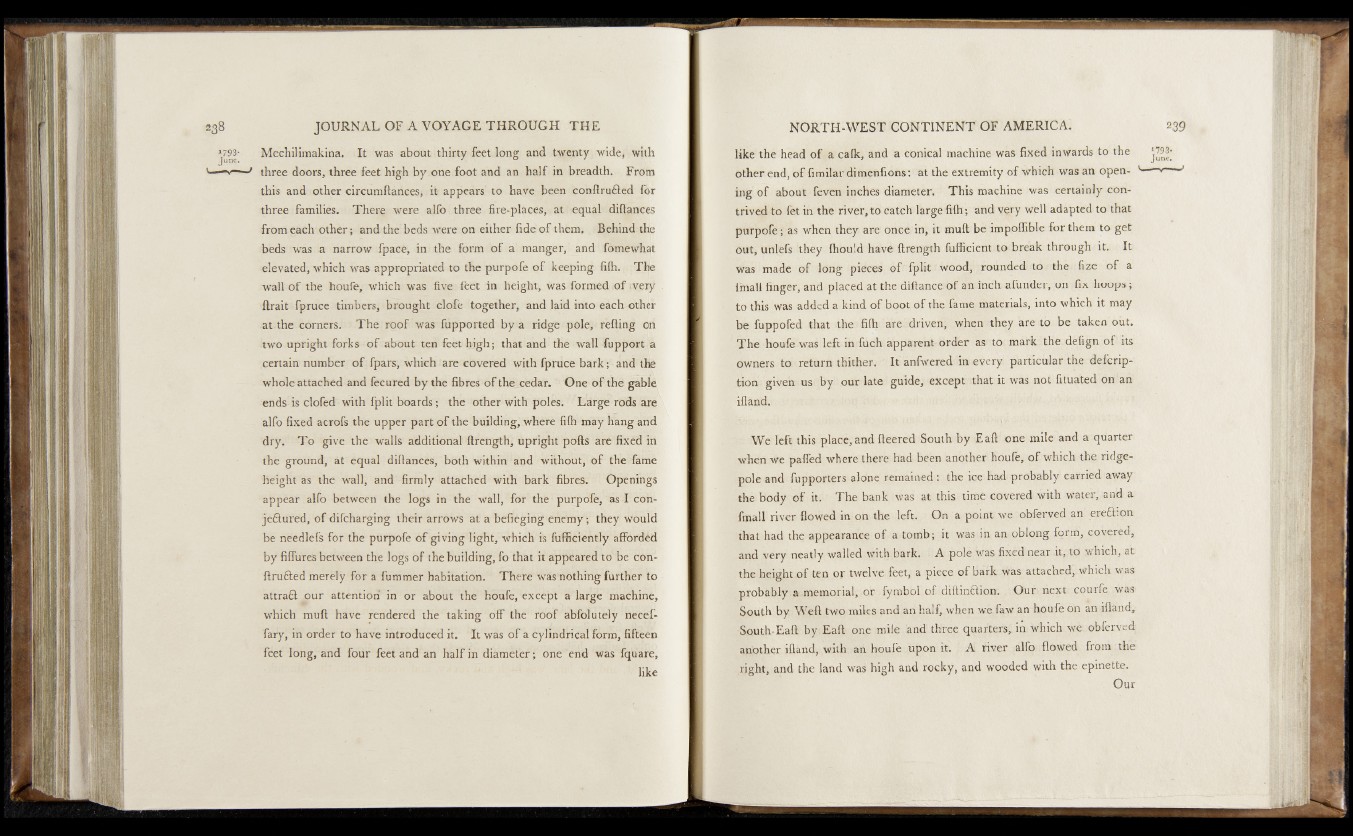
Meehilimakina. It was ab'Oàfc* thirty feet Jong and t^entÿjiwidè/^ith
three doors, three feet high hy.onefoot and an half in breadth. From
this and other circumftaiiees; it- appears to have -been cohflra&edTbr
three families. There were alfo i three fire-places;: at : -equal1, diftances
from each other ; and the beds were on either fide of them. Behind, the
beds was a narrow fpacé, im the form of a -manger, and1 fèmewhat
elevated, which was appropriated to the purpofe o f keeping fifh. The
wall of the houfe, which was five feet in height, was formed o f tvery
ftrait fprüee timbers; brought clofe together, and laid into each other
at the coriiers.: . The.’ rööf was fiipported by a fid^^pol^* refiing dti
two upright forks- ©f about ten feet? high ; that and thé wall Support l a
certain number of -fpars, which are covered with fprucê bark; and the
whole attached and fecured by the fibres of the cedar. One of the gable
ends is clofed with fplit boards ; the ’other with poles. Large rods are
alfo fixed acrofs the upper part o f the building, where filh may hang and
dry. -To give the walls additional' ftrength, upright pofts are'fixéd in
the ground, at equal dillances, both within and without, of the fame
height as the wall, and firmly attached with bark fibres. Openings
appear alfo between the logs in the wall, for the; purpofe, ;as-I conjectured,
of difeharging their arrows at a befreging eneiny; they Would
be needlefs for the pufpofe óf giving light,' which ïs fuffièientfy afiórdéd
by fiflures between the logs of the building, fo that it appeared 'tomé COn-
ftruétèd merely for a fummer habitation. There wâ$*nb&Jrtg further to
attraft our âtïénfciénP in or about ther ho'ufe, ’excèpt ä-; latge ‘machine,
which muft have rendered the' taking off abfólütèÏy‘hêcéffafy,
in order to have introduced it. ’ It' wäs of a Cylmdrical form, fifteen
feet long, and four feet and an half in diameter f one' end was fquàre,
like
like the head of-a calk, and a conical machine Was fixed inwards to the
Other end, of fimilar dimenfions:' at the extremity of which was an open- v— ■
ing of about feven-inches diameter. This machine was certainly contrived
to fet in the fiv^tbeatéh largéfelht ands y0y w%ll adapted to that
purpofe; as when they, are'ott&éiin, it muft’be impoffiblefor them to get
Out, unlefs thèy fhöuld have ftrength fefficiehtAUHbr^k: through (it. It
Was made of long «pieces éfe fplit: wood, . rounded-to 'the- fixe .of a
fmall finger, and ■ placed at thediftanceibf an-inuh. afunder, on fix. hoops;
to this was added a kind of boofeof the.fa me materials, into which ife..may
be fuppofed that the filh areadriven; when they are to be "taken oixt.
The houfe was1 left in;fUch apparent- order as to mark : thedefignof its
éwners t e ;return thither. ' ItVanfwered. in every! particular the deferip-
tion giveh us by our late guide, except ithat it was not fiiuated On an
iflaBidss
S:We< feft this place, and fleered South by Eaft one mile-iand aqUarter
when we paffed where there had been another houfe, of which ‘the ridgepole
and fupporters alone remained ï .the ice had probably? carried away*
the Body ©f it. The? bank k a s at this time covered with wat&ir^and a
finall river flowed inqn the deft. On a>poiutf w.&.obferved an. efléQaqw.
that had the appearance of. a<to*nb; it wasun artyobiong forna^^covered,
and very neatly walled with.bark.- A pole was ii^tiineapitjAd which, at
the heigbtxif tép or twelvCifeet^ a p,ieep of BatitcMhs-attached1,iwhfeh was
probablyiaomemonal, j ohTy mb,bLtftUdiftimQJ®tt; , Oufi next! cqurfewa®
South by Weft two miles andean half, when ..wyfkw an houfe ©^. anifland,
South-Eaft by;Eaft1 pnf imile andlthfree quarters^ ini which wet.obfeEvJedj
Mother ifland, with.,*an l^oufe ftpon. it; A fiver ;alib, flowed frora.:the
right, and the land was high and rocky, and wooded with the/.epinette.
Our